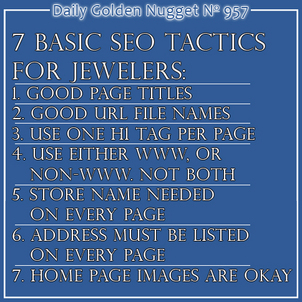 In this edition of the Daily Golden Nugget, I'd like to share with you my recent thoughts and experiences of the basic search engine optimization factors based on what I see in my daily tracking of many jewelry websites.
In this edition of the Daily Golden Nugget, I'd like to share with you my recent thoughts and experiences of the basic search engine optimization factors based on what I see in my daily tracking of many jewelry websites.On a weekly basis, I mention a few of these during my Friday website reviews. This is by no means an exhaustive list of SEO techniques; just the 7 most important ones that I've noticed in the past several months.
1. Title Tags - Every page of your website must have one. They should be unique and they should be descriptive of what the page is about. Don't include your store name in the title tag except on your Home Page. The Home Page title tag should show your store name first, followed by important keywords, then your town name.
2. File Names / URLs - The URL of your web pages should not rely too heavily on variable strings. Try to name the pages of your site with actual file names rather than using variables. In other words, your Home Page should be the "index.php" file name and your About Us page should be "about-us.php" rather than having "index.php?page=about."
3. H1 - Use the H1 HTML tag to indicate the "header" or "headline" of every page of your site. Although several SEO professionals say this tag is useless, I maintain that it's still important because of its built-in emphasis as the most important headline on your page. Why would Google ignore it? Just make sure you only use it once, and at the top of your page.
4. WWW and non-WWW addresses - Make sure your website is reachable if you type in thehttp://www.doman.com orhttp://domain.com. However, you should always force the user to one version or the other, rather than allowing both. Several bad things can happen if you do allow both, like duplicate content, devalued link sharing, and potential security problems on e-commerce websites.
5. Store Name - Include your store name as text, not an image, somewhere on every page of your site. Typically this is in your footer, but it also makes sense to show it very large at the top of your home page. However, other than your store logo at the top of every page, there's no need to include the same "Welcome to XYZ Jewelry Store" at the top of every page.
6. Store Address - Include your address in the footer of every page of your website. This is the only way I've found that allows Google to correctly relate all the information on your website to your store, and address. I've seen this method work for up to 3 store locations, and Google will use this association to include all of your website in local (town name) related searches. Those of you with more than 3 jewelry stores will need to create an individual page for each location. Sadly, in the multi-location scenario, it's usually only those individual pages that will rank for local searches.
7. Home Page Images - I'm not a fan of these findings because I know they will create the wrong impression. I've discovered that you can successfully rank your home page even if you don't have any readable text on it. In fact, you can have several images that change using one of the popular slider or fading JavaScript techniques. There are a few tricks to making this work. First, you still need a lot of content on your website, which I refer to as "support content." Second, the images on your home page should have SEO rich file names. Third, the images on your home page should have SEO rich "alt" and "title" attributes.
Keep this list handy as you work on your basic search engine optimization techniques. It's easy to become complacent with the SEO basics, especially if you do this type of work over and over again.








